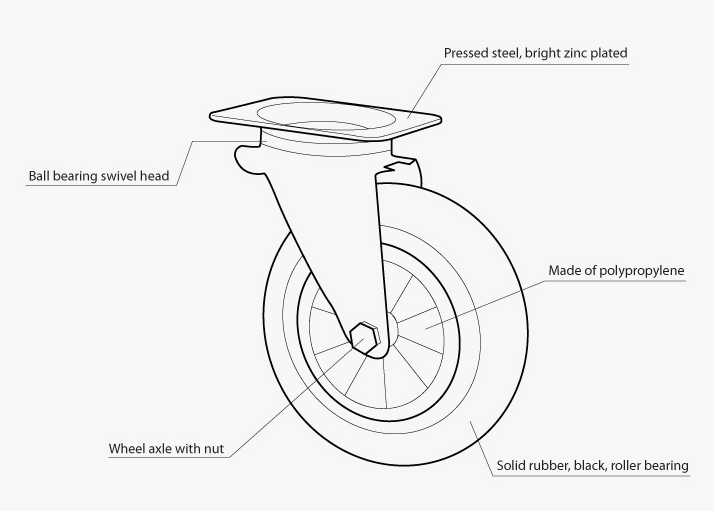6: Produciton and Construction Techniques
- Page ID
- 177916
Scenery encompasses all the physical decorative elements of the stage design. It includes curtains, platforms, stairs, walls, furniture, and all of the other items a show might require for its visual environment. Scenic designs are delivered to the technical director as a set of plans for the design. The technical director drafts any additional “working drawings” necessary for construction and then distributes the scaled plans to the scene shop. Drafted plans are drawn in a “language of lines” and standard graphic symbols that are generally understood by those who need to interpret them. Each draft has a title block in one corner that tells you what the drawing represents and how to interpret its scale for construction, as well as who created it and when it was drafted or last revised.
Walls that we construct as flats and raised platforms that create levels, also referred to as decks, are the most commonly constructed elements for scenery. Of course there may be lots of other items that a scenic design utilizes or requires, but these elements are standards for set construction.
Often, platforms that need to be moved are bolted to casters. Casters are a mounted wheel that is already attached to an axle and steel plate so that they can easily be attached and detached to scenic units. There are two traditional types, straight casters which can only move in one linear direction, and swivel casters which can roll in any direction.

Figure \(\PageIndex{1}\): A Swivel Caster
As scenery represents a large portion of the physical needs for a production, it is often the most labor intensive of the design elements and usually maes up a significant part of the budget. It stands to reason that the less you need to build from scratch, the more time and money can be saved or allocated to other production needs. Stock scenery items are those that the theatre stores between productions and can be reused, redressed, or altered for a production. Companies that have allocated space to store scenic elements such as flat walls and platforms can effectively and economically reuse them. Storage, therefore, is a premium in theatre spaces, and you usually find that something is stored in every nook and cranny of a theatre space in case it might be useful in the future. Environmentally, it also makes sense to reuse as much as possible because plays tend to have relatively short performance runs, and the art form could otherwise be seen as wasteful.
To be most useful, stock scenery should be constructed in sizes that are commonly required and can be assembled in a variety of configurations. Therefore, stock sizes of scenery are also common. Flat walls are generally constructed in 1-, 2-, 3-, or 4-foot widths. Heights are dependent on the most useful size for a given stage space.
Some flats can be 20-feet tall or taller, while the most common sizes are 8 feet, 10 feet, 12 feet, 14 feet and 16 feet.
Flats are commonly constructed in two basic types. A soft-cover flat is constructed on a frame, usually of wood, but sometimes metal. A canvas is stretched over the entire plane that faces the audience. Much like a large painter’s canvas, a flat can be painted to resemble any environment. Soft-cover flats are both lightweight and portable and have been traditional elements of scenery for hundreds of years. Each of the joints of the flat’s frame is supported by a thin plywood brace. These corner blocks and keystones help to stiffen the relatively thin flat frames. These frames, often constructed of 1-by-3- or 1-by-4-inch lumber, are economical to construct and their minimal thickness (approximately 1 inch each) reduces storage space. However, their relative delicacy due to the soft-cover makes them an unpopular choice in modern theatre. While there was a time when it was standard for performers to act in front of the scenery, modern plays require them to interact with the scenery, making canvas walls impractical.
Hard-cover flats are also commonly built as wooden frames, but their face is covered in a thin plywood rather than canvas. This makes them more durable, but also heavier and generally more expensive to construct. The most common version of a hard-cover flat is the “studio” or “Broadway” style flat. These frames are not only stiffer than other styles, but their depth also allows them to be easily secured to one another as well as to the floor. If your production requires actors to lean on the set’s walls or throw things against them, a hard-cover flat is your best choice.
Sometimes, tall flats can become unstable or "wobbly" when attached together over long distances. To keep large walls of flats from shaking technicians often attach a stiffening batten - sometimes also referred to as "hogs trough" because of its shape. A stiffening batten is usually a simple length of 1x3 pine attached to a flat to keep it from wiggling.

Flats are sometimes constructed in shapes other than rectangles. If a flat is constructed to have a shaped edge profile, we refer to it as a profile flat. Tree shapes and arches are common profile flats. Flats can be propped up by triangular frames called jacks where needed for support.
In construction, carpenters often use industry specific words to describe techniques and practices and they can often to be confusing to the uninitiated. Flush, proud, and shy are three such words.
- Flush: Smooth, level, even.
- Proud: Slightly projecting from a surface.
- Shy: Slightly recessed from a surface.
Platforms are often constructed as frames that support a full sheet of plywood as their top skin surface, or lid. In the U.S., plywood is sold in sheets that measure 4 feet by 8 feet, and so platforms are constructed this size or smaller. Groups of stock platforms can be assembled into larger decks of stage levels with support legs that set their heights above the natural stage floor. A facing can be added to these platforms that hides the legs so they appear as solid block shapes to the audience.
Typical framing for a wooden theatrical platform can be constructed from either 2-by-4 or 1-by-6-inch boards. Framed on-edge, both materials provide the necessary support the plywood lid requires. Joists that span the 4-foot width of the frame need to be installed on 24-inch centers in order to provide the stiffness and weight distribution required for the platform to safely support scenery and performers. A stage platform is typically skinned in ¾-inch thick plywood and supported by a minimum of six legs. Metal platform frames are also common to large productions and touring shows.
When installing platforms on a stage floor, it can often be the case the the stage floor is not perfectly level. This unevenness can get amplified with tall platforms, leaving differences in heights of the platforms, leading to potential tripping hazards. To keep platforms level, a simple shim can be placed under platform legs as needed. A shim can be any piece of scrap wood or metal used to raise adjacent parts of scenery so that they are level. Waiters at restaurants often use shims to keep tables from wobbling.

If we add levels to our stages, we need stairs to get from one height to another. Humans have an interesting relationship with stairs. Most of us do not need to carefully navigate each rise in a staircase, but instead have an autopilot feature that usually allows us to climb or descend them with ease. This is true until one stair is of a slightly different rise than the rest, then we are apt to trip and fall at this step. Designers should take care to ensure, as much as possible, that all of the stairs on a given set are of the same height so the actors can traverse them easily without great concentration. Many theatres keep stock stair units as a part of their inventory.
After all of the scenery has been constructed (often offsite in a scene shop), it is time to install it into the theatre on a load-in schedule. Sometimes load-in can take mere hours, while more complex produciton can load-in over multiple weeks. After the show has finished, technicals arrive with trucks and strike the show or compete load-out, sometimes into trucks for its next destination.
There’s More to Know When constructing stairs for a set, it is helpful to use the 18-inch rule for your calculations. The rise of each tread to the next and the run or depth of each tread when added together should add up to 18 inches. Therefore, if a 6-inch rise from tread to tread is required, then your run or depth of tread should be 12 inches. If your rise is 8 inches per tread, then your stairs should each have a 10-inch run depth. This will keep the natural rhythm of human movement intact.
All Staircases should be with in 6 to 8 inches of rise.
For Further Exploration Raoul, Bill. 1998. Stock Scenery Construction : A Handbook. Louisville, KY: Broadway Press. International Alliance of Theatrical Stage Employees. n.d. Accessed August 16, 2018. http://www.iatse.net/.
This chapter was updated and remixed from content created by


